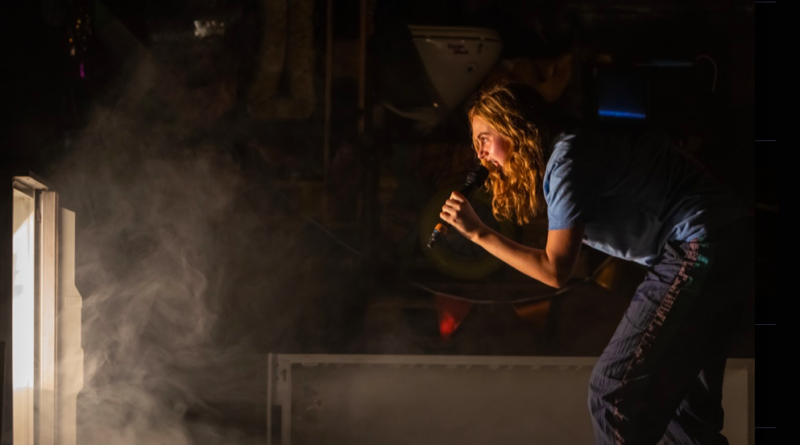REVIEW: Enda Walsh’s ‘Safe House’ is transfixing theater
Photo: Safe House features Kate Gilmore as Grace. Photo courtesy of St. Ann’s Warehouse official website.
NEW YORK — For adventurous theatergoers, there’s nothing like an Enda Walsh play. The Irish writer has been behind some of the best, most interesting theater of the past few years, with many of his productions heading across the pond to St. Ann’s Warehouse in DUMBO, Brooklyn. That’s where his latest is located: Safe House, written and directed by Walsh, continues through Sunday, March 2, in a tragically short run.
Even for the adventurous Walsh-heads in the crowd, Safe House can be disorienting and head-scratching — but in all good ways. The 90-minute piece, which feels like an amalgam of a concert and play, stars Katie Gilmore, who plays a character named Grace making her way through a songbook courtesy of Anna Mullarkey. Some of the lyrics of her recitations are broadcast on the back wall of the stage; in fact, the many projections that encompass this piece are an aesthetic highlight of the production. The images and words provide context and some semblance of a narrative.
This character has a lot to say, but what is said (or sung) is never delivered in a straightforward, easy-to-understand manner. There’s no beginning, middle or end; instead, the piece begins in medias res, with the audience left to pick up the pieces and figure out how this solitary woman has found herself in a disheveled domicile of sorts, traipsing around a garbage-strewn floor. At times, she climbs a ladder and emotes from atop a chest of drawers. At one point, she enters the stage sailing onboard a moving throne, capped off with a toilet. A rug is unfurled; movie theater seats provide a momentary respite.
A traditional story surrounding this woman is mostly non-existent, but pieces emerge and disappear. There definitely seems to have been some past trauma in her life, evidenced by some of the lyrics that are sung, the voices that are heard and the blood that can be seen. Even the title of the work, Safe House, speaks to a protection that is afforded by these rough-and-tumble four walls.
The music by Mullarkey is beautifully written and wondrously sung by Gilmore. They are not catchy ear-worms or danceable beats. They are poetic conveyances of emotion and catharsis. They are incapable of moving the narrative forward because narrative structure is mostly missing, so instead these songs serve as a checkin with Grace, to see how she’s doing and how she’s processing this lonesomeness.
Gilmore is the true highlight of Safe House. She offers theatergoers a towering, commanding performance that is heartbreaking and frenetic, solemn and punk rock. She portrays Grace on stage, and then she tears down the character, only to rebuild her again and again — all with a microphone in hand. There’s nothing quite like her performance on any other stage in New York City at the moment.
Perhaps the overriding theme of Safe House is a feeling of being alone. There’s great potential with quiet time and a place to call one’s own, but there’s a simultaneous pull to reenter the world and interact with people. But what if the memories are too difficult to face? What if safety is not secured outside the walls of one’s home? What happens when the protective quarters of a house become unsafe?
Walsh, in a program note that he seems loathe to write, mentions that this is a “story about surviving, about trying to keep the past from dragging us backwards.” One wonders if being alone, with only inner-thoughts and inner-monologues to keep one company, helps or hurts this outrunning of the past. How does one forget?
Perhaps the environment of the stage at St. Ann’s Warehouse is intentionally surreal because this is some type of dreamscape, some type of alternate reality. Perhaps Grace is sleeping. Perhaps she’s invited the audience into a dream. Or, perhaps, this is all too real.
There’s one image near the end of the show that finds Grace finding a certain type of refuge. It’s best to keep the details of this refuge a secret, but it brought this reviewer to tears because there’s an undeniable desire, on the audience’s part, to have Grace survive, to have her find safety.
Whatever might be happening in Safe House, the play promotes pondering and achieves Walsh’s ultimate goal, which he outlines in that program note: “I hope you talk about it.”
By John Soltes / Publisher / John@HollywoodSoapbox.com
Safe House, written and directed by Enda Walsh, features music by Anna Mullarkey. Kate Gilmore stars in the 90-minute show. Continues through Sunday, March 2, at St. Ann’s Warehouse in DUMBO, Brooklyn. Click here for more information and tickets.

